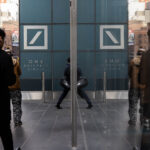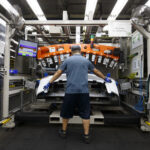Clothes that make people stand out to human drivers may make them invisible to automated crash prevention systems, a new study suggests.
The Insurance Institute for Highway Safety studied conspicuous clothes and crashes into pedestrians in a report released on Thursday.
Past IIHS research has shown that pedestrian automatic emergency braking (AEB) systems reduce the rate of pedestrian crashes of all severities by 27%. On dark roads, however, the effect of pedestrian AEB on crash risk is negligible.
That’s a big problem because most fatal pedestrian crashes occur at night, according to the IIHS.
The study investigated the effects of conspicuous clothing and increased roadway lighting on the performance of the pedestrian AEB systems in three 2023 models: a Honda CR-V, Mazda CX-5 and Subaru Forester.
Researchers conducted multiple trials with an adult-sized dummy clothed in a black sweatshirt and pants, a retroreflective jacket with black sweatpants, the black sweatshirt and sweatpants with retroreflective strips added on the dummy’s limbs and joints and a white sweatshirt and pants. The retroreflective strip pattern used was similar to the one seen on roadway worker outfits.
The tests were run at 25 mph in three conditions: with no roadway lighting, with 10 lux of illumination in the crosswalk and with the federally recommended 20 lux of illumination in the crosswalk.
The dummy crossed the track perpendicular to the path of the vehicle in all scenarios.
The CR-V and CX-5 hit the dummy in 84% and 88% of the test runs, while the Forester avoided a collision in all but one trial. Neither the CR-V nor CX-5 slowed at all when the dummy was wearing clothing with reflective strips that articulated its limbs. Otherwise, the performance of the Honda and Mazda crash avoidance systems varied, according to the IIHS.
When the dummy was dressed in black, both vehicles slowed substantially when using their high beams — a test that was only conducted with no roadway illumination. Using their low beams in those same conditions, the CR-V failed to slow at all and the CX-5 reduced its speed by less than a third. Both vehicles did much better with 20 lux of additional light.
For all the other types of clothing, the vehicles were only tested using their low beams.
The rest of the findings include:
- When the dummy was dressed in the reflective jacket, the CR-V didn’t slow in any of the trials, regardless of additional roadway lighting. In contrast, with no roadway illumination and with 10 lux of added light, the CX-5 slowed much more than it did when the dummy was clad in black. But with 20 lux of added light, it performed worse with the dummy in the reflective jacket than when it was wearing the black outfit.
- When the dummy was dressed in white, the CR-V didn’t slow at all without added roadway illumination but notched up its best performances with 10 and 20 lux of added light. However, it did better with 10 lux of illumination than with 20 lux.
- The CX-5 performed better than it did with the dummy in black but not as well as with the dummy wearing the reflective jacket. It also slowed less with increased roadway illumination when the dummy was wearing white.
- In contrast to the two other vehicles, the Subaru came to a complete stop without hitting the pedestrian dummy in every trial except one run in which the dummy was wearing clothing with reflective strips and the roadway was illuminated to 10 lux. Even in that run, it slowed by more than 80%.
“These results suggest that some automakers need to tweak their pedestrian automatic emergency braking systems,” stated IIHS President David Harkey. “It’s untenable that the clothes that pedestrians, cyclists and roadway workers wear to be safe may make them harder for crash avoidance technology to recognize.”
Automakers are already working to address the issue in response to IIHS ratings that now emphasize nighttime performance, but in the real world a host of factors come into play, according to the institute.
Was this article valuable?
Here are more articles you may enjoy.

 Supreme Court Refuses to Revive Youths’ Climate-Change Lawsuit
Supreme Court Refuses to Revive Youths’ Climate-Change Lawsuit  Deutsche Bank, Mudrick Sue Ambac Over $65 Million Transfer
Deutsche Bank, Mudrick Sue Ambac Over $65 Million Transfer  Carney Pledges Billions for Canada Auto Sector in Trade War
Carney Pledges Billions for Canada Auto Sector in Trade War  New Fire Maps Put Nearly 4M Californians in Hazardous Zones
New Fire Maps Put Nearly 4M Californians in Hazardous Zones 